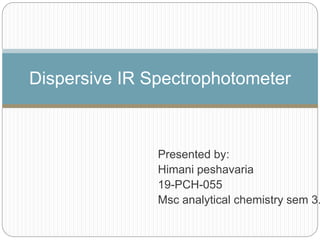
Dispersive ir spectrophotometer
- 1. Presented by: Himani peshavaria 19-PCH-055 Msc analytical chemistry sem 3. Dispersive IR Spectrophotometer
- 2. Contents Principle Instrumentation Working Applications Disadvantages
- 3. Principle IR Spectroscopy detects frequencies of infrared light that are absorbed by a molecule. Molecules tend to absorb these specific frequencies of light since they correspond to the frequency of the vibration of bonds in the molecule. The energy required to excite the bonds belonging to a molecule, and to make them vibrate with more amplitude, occurs in the Infrared region. A bond will only interact with the electromagnetic infrared radiation, if it is polar.
- 4. Instrumentation An IR spectrometer consists of three basic components: 1. Radiation source. 2. Monochromator. 3. Detector.
- 5. 1) Radiation source The common radiation source for the IR spectrometer is an inert solid heated electrically to 1000 to 1800 °C. Three popular types of sources are : a) Nernst glower (constructed of rare-earth oxides), b) Globar(constructed of silicon carbide), c) and Nichrome coil.
- 6. a) Nernst glower It is composed of rare earth oxides e.g., zirconium oxide , yttrium oxide. It consists of a hollow rod with a diameter of 1 to 2 mm and a length of perhaps 20 mm. Platinum ends leads to passage of electricity.
- 7. It is non conducting at room temperature and must be heated by external means to bring it to a conducting state. Advantage is that it produces intense IR radiation and IR range is also wide. Disadvantage of Nernst glower is its frequent mechanical failure.
- 8. b) Globar It is a rod of silicon carbide, usually about 5 cm in length and 0.5 cm in diameter. It is heated to a temperature between 1300 and 1700 °C.
- 9. c) Nichrome coil. It produces a lower intensity of radiation than the Nernst or Globar sources, but has a longer working life. The wire source is a tightly wound coil of nichrome wire. Electrically heated to 1100 °C.
- 10. 2) Monochromators Monochromator splits polychromatic light into monochromatic light. They are mainly of two types: a) Prism monochromators. b) Grating monochromators.
- 11. a) Prism Several materials are used for the construction of prism. Quartz is employed for near IR region. Crystalline sodium chloride is the most common prism material. Its dispersion is high between 5-15 μm. Crystalline potassium bromide and cesium bromide provide prism materials for far IR. Lithium fluoride is useful for near ir region.
- 12. b) Grating A grating is a device that consists of a series of identically shaped, angled grooves. Gratings for the infrared region have a much wider spacing between the grooves.
- 13. 3) Detectors Most detectors used in dispersive IR spectrometers can be categorized into two classes: a) photo detectors : they use the quantum effect of the infrared radiation to change the electrical properties of a semiconductor. b) Thermal detectors : IR radiation produces a heating effect that alters some physical property of the detector.
- 14. a) Photo detectors They are constructed from semi conductor crystals such as lead sulfide, lead selenide and germanium. Absorption of radiation by these materials results in excitation of non conducting electrons to an excited conducting state. The increase in conduction or decrease in resistance can be readily measured and is directly related to the number of photons reaching the semiconductor surface.
- 15. b) Thermal detectors Thermal detectors are mainly of three types : 1. Thermocouple 2. Bolometer 3. Golay cell
- 16. 1) Thermocouple Thermocouple consists of a pair of junction of different metal wires. The potential difference (voltage) between the junctions changes according to the difference in temperature between the junction. Hence, current flow which is altered is recorded by the recorder.
- 17. 2) Bolometer It consist of a thin metal conductor When radiation falls on this conductor, its temperature changes, as the resistance of a metallic conductor changes with temperature. When no radiation falls on the bolometers, the bridge remains balanced. If radiation falls on the bolometers, the bridge become unbalanced due to changes in the electrical resistance which causes a current to flow through the
- 18. 3) Golay cell It consists of a small metal cylinder which is closed by a blackened metal plate at one end and by a flexible metalized diaphragm at the other. After filling the cylinder with xenon, it is sealed. When IR radiation is allowed to fall on the blackened metal plate, it heats the gas which causes it to expand. The signal seen by the device is modulated in accordance with the power of the radiant beam
- 19. Working Two equivalent beams from the same source pass through the sample and reference chambers respectively. Using an optical chopper, the reference and sample beams are alternately focused on the detector. Commonly, the change of IR radiation intensity due to absorption by the sample is detected as a signal that is translated into the recorder response through the actions of synchronous motors.
- 21. Applications Identification of all types of organic and many types of inorganic compounds. Determination of functional groups in organic materials. Determination of molecular orientation . Determination of molecular conformation (structural isomers) and stereochemistry ( geometrical isomers ).
- 22. Disadvantages Slow scan speed make dispersive instruments too slow for monitoring systems undergoing rapid changes . Less sensitivity . Many moving parts may results in mechanical slippage . Accuracy is less compared to Fourier Transform IR(FTIR) .
- 23. References Introduction to Spectroscopy Book by Donald L. Pavia, Gary M. Lampman, and George S. Kriz Handbook of Instrumental Techniques for Analytical Chemistry Book by Frank A. Settle. Principles of Instrumental Analysis 6th Edition by Douglas A. Skoog , F. James Holler , Stanley R. Crouch . http://www.authorstream.com/Presentation/vvkvjoshi -1948442-dispersive-ir-spectrophotometer/ http://delloyd.50megs.com/MOBILE/infrared_spectro scopy.html spectroscopyinstrumentationby-dr- 190618085453.pdf